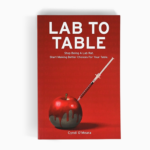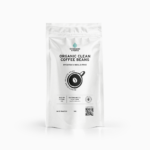I received a press release from Frontier Foods with the heading ‘Plant-Based Meat: A Healthier Choice?’.
Immediately I frowned at the audacity of the suggestion that this could have any truth behind it – the suggestion that plant-based meats are healthier than meat, chicken and fish. Remember this is the assumption I gleaned as a nutritionist, so I’ll assume other people may also have thought the same.
At the beginning of the press release was the following:
“A new report, published yesterday, has confirmed that plant-based meat is indeed a healthy swap for conventional meat”.
40 years of nutrition has taught me to question any headline that proclaims real food as being bad and fake food as being better.
I’ve written in my book Lab To Table and posted on my Instagram page @Changing_Habits many comparisons of fake vs real, looking at the ingredients as the starting point, including margarine vs butter, vegan cheese vs real cheese, fake meat vs real meat, real eggs vs fake eggs, real chocolate vs fake chocolate, real supplements vs fake supplements and so on. In my way of thinking, there is no comparison: one is a complete chemical storm, the other a food we’ve eaten for thousands of generations.
Most people don’t have 40 years of nutrition to decipher a headline from mainstream media and decide whether it is right or wrong. So I’d like to help you make a decision without having to read the 62 page report on ‘Plant-Based Meat: A Healthier Choice?’.
Before I go into the report, let’s look at what’s important.
One of the arms of Changing Habits is my education company – The Nutrition Academy. We have several courses in the academy based on nutrition and human health as well as food production. Each course begins with an historical look at the food we eat and how it is produced. We also introduce a philosophy that then becomes a guiding light to help people make better choices for their health.
We do not banter about carnivore, vegan, vegetarian, omnivore or pescatarian but rather teach what humans consumed in order to survive for thousands of generations to get to this point in time.
In short, humans were adaptable. Depending on where they lived and what food was available, they adapted to the food and the climate. The food they consumed was not processed but rather was real food including dairy, meat, fowl, fish, nuts, seeds, legumes, grains, herbs, spices, eggs, vegetables, fruit, fungi and grain.
Some humans who lived in extreme places, like the Arctic Circle, at high altitude or in deserts, ate a diet rich in animal produce and meat. Whereas cultures that lived in the tropics on islands ate a more plant-based diet.
The macronutrients humans ate varied as much as 90% plant based and 10% animal based, all the way to the extreme opposite of 90% animal based to 10% plant based. There was never a rhetoric on macronutrients (ie what was better), it was simply a matter of adapting to what foods were available. The food was not ultra-processed but real food. The food was good quality and preparation of the food was based on culture and traditions.
Modern human eating habits have thrown out thousands of generations of culture and tradition and created a slick marketing campaign in order to sell the next ‘best’ ultra-processed foods, using cleverly designed chemicals made in a laboratory or using synthetic biology (genetically modified microbes).
Once the students of The Nutrition Academy have learnt about anthropology, they then learn the philosophy of vitalism. Vitalism is looking at the body, food and world as a whole rather than in its parts. Medicine and nutritional guidelines work on the philosophy of mechanism. Mechanism is where we break down the body or food into its component parts as opposed to looking at the body and food in its entirety.
There are times when mechanism is good to understand, for instance in times of emergency. But when it comes to health and the prevention of disease, vitalism is a wonderful philosophy to guide you in your food choices and to live a healthy lifestyle. When it comes to food choices, many people are taught to use the philosophy of mechanism as their guide – that is to look at the carbohydrates, proteins, saturated fat, salt and sugar content of a food. I was taught to do this at university.
When we use vitalism to guide our food choices, we look at the ingredients. If the ingredients look like a chemical storm (with colours, flavours, acidity regulators, thickeners, gums to name a few) you leave it on the shelf, but if the ingredients are real foods then you may consider this to be a food that your body will recognise.
As my anthropology university professor said to me recently in an interview: “If we haven’t been eating it for 15,000 years, don’t touch it.”
Foods the Report Compared With Plant-Based Meats
The 62-page report ‘Plant-Based Meat: A Healthier Choice?’, written by an accredited dietitian, with several pages of references, would take me another 62 pages to critique, but there are some key things that you should know.
The ingredients of plant-based meats are not really the focus of the report, but rather the salt, type of fat, protein and carbohydrate content. But if you read the ingredients of the plant-based meats, in my opinion they all look like a chemical storm.
The report says that the plant-based meats are lower in sodium and lower in fat, especially saturated fat, and comparable with protein content.
But when you look at the ingredients you may see the following:
Rehydrated Textured Soya Protein (58%), Rapeseed Oil, Water, Onion (9%), Seasoning (Yeast Extract, Malted Barley Extract, Onion Powder, Flavouring, Salt, Garlic Powder), Stabiliser: Methyl Cellulose, Chickpea Flour, Flavouring, Garlic Purée, Malted Barley Extract, Onion Powder.
Things that we need to consider when looking at these ingredients include how they are made and the agricultural practices that produced the protein. Are they Roundup-ready GM soya and Roundup-ready GM canola (rapeseed oil)? If they are not genetically modified and not certified organic, were the chickpeas, soy or rapeseed dried before harvest (a common agricultural practice) using glyphosate (a probable carcinogen).
How are the flavours made? Are they made using synthetic biology or has a group of chemicals (up to 100) been used to create the desired taste? You see, when you read the ingredients you also need to read between the lines. My book Lab to Table will help you understand the concepts I’ve briefly talked about here.
Another disturbing assumption made in the report is that the body perceives chemicals the same whether they are from food or from a laboratory. Sorry, but no matter how many times I hear this it just doesn’t compute. Looking at real food vitalistically, it is innately and intelligently put together by nature. Nature has managed to help the earth, animals and humans survive for a long time.
Humans may think they are smarter than nature and that they can put a bunch of chemicals together that look like food, taste like food, smell like food but not be food and think that the human body will remain healthy. There are many studies that show that people who eat ultra-processed foods (fake food) have one or more chronic conditions including obesity, heart disease and diabetes.
The report also talks about these plant-based meats being ‘transitional’ foods. That means that they are used to help people find a way to healthy eating. Eating junk and ultra-processed food to create healthy eating seems like a bit of an oxymoron to me.
But This is the Real Clincher…
In the report, they were not comparing meat, chicken and fish to the plant-based meats but rather they were comparing hot dogs, deli meats, sausages and conventional hamburgers to the plant-based meats…
DOH!
They did compare plain mince to the plant-based meat and of course common sense would tell you that the fake meat was inferior in nutrition. The mince had one ingredient while the plant-based meat contained many ingredients/chemicals.
A group of ingredients are never studied as a group, they are only studied as individual chemicals, so when you group them together the real health outcomes and long-term health consequences are not known.
As my new book says, stop being a lab rat and start making better choices for your table…and don’t be fooled by clever headlines.
If you would like to read the report, click here.







0 Comments